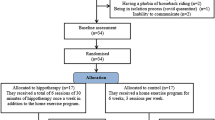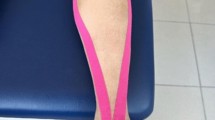Abstract
A number of occupational and leisure activities that involve pushing are performed in symmetrical or asymmetrical stance. The goal of this study was to investigate early postural adjustments (EPAs), anticipatory postural adjustments (APAs), and compensatory postural adjustments (CPAs) during pushing performed while standing. Ten healthy volunteers stood in symmetrical stance (with feet parallel) or in asymmetrical stance (staggered stance with one foot forward) and were instructed to use both hands to push forward the handle of a pendulum attached to the ceiling. Bilateral EMG activity of the trunk and leg muscles and the center of pressure (COP) displacements in the anterior–posterior (AP) and medial–lateral (ML) directions were recorded and analyzed during the EPAs, APAs, and CPAs. The EMG activity and the COP displacement were different between the symmetrical and asymmetrical stance conditions. The COP displacements in the ML direction were significantly larger in staggered stance than in symmetrical stance. In staggered stance, the EPAs and APAs in the thigh muscles of the backward leg were significantly larger, and the CPAs were smaller than in the forward leg. There was no difference in the EMG activity of the trunk muscles between the stance conditions. The study outcome confirmed the existence of the three components of postural control (EPAs, APAs, and CPAs) in pushing. Moreover, standing asymmetrically was associated with asymmetrical patterns of EMG activity in the lower extremities reflecting the stance-related postural control during pushing. The study outcome provides a basis for studying postural control during other daily activities involving pushing.





Similar content being viewed by others
References
Alexandrov AV, Frolov AA, Horak FB, Carlson-Kuhta P, Park S (2005) Feedback equilibrium control during human standing. Biol Cybern 93:309–322
Aruin AS (2006) The effect of asymmetry of posture on anticipatory postural adjustments. Neurosci Lett 401:150–153
Aruin AS, Latash ML (1995) Directional specificity of postural muscles in feed-forward postural reactions during fast voluntary arm movements. Exp Brain Res 103:323–332
Aruin AS, Latash ML (1996) Anticipatory postural adjustments during self-initiated perturbations of different magnitude triggered by a standard motor action. Electroencephalogr Clin Neurophysiol 101:497–503
Baril-Gingras G, Lortie M (1995) The handling of objects other than boxes: univariate analysis of handling techniques in a large transport company. Ergonomics 38:905–925
Basmajian JV (1980) Electromyography–dynamic gross anatomy: a review. Am J Anat 159:245–260
Belen’kii VE, Gurfinkel VS, Pal’tsev EI (1967) Control elements of voluntary movements. Biofizika 12:135–141
Bertucco M, Cesari P, Latash ML (2013) Fitts’ Law in early postural adjustments. Neuroscience 231:61–69
Bonnet CT (2012) Broad stance conditions change postural control and postural sway. J Mot Behav 44:125–131
Brown SH, Haumann ML, Potvin JR (2003) The responses of leg and trunk muscles to sudden unloading of the hands: implications for balance and spine stability. Clin Biomech (Bristol, Avon) 18:812–820
Cholewicki J, McGill SM (1996) Mechanical stability of the in vivo lumbar spine: implications for injury and chronic low back pain. Clin Biomech (Bristol, Avon) 11:1–15
Couillandre A, Maton B, Breniere Y (2002) Voluntary toe-walking gait initiation: electromyographical and biomechanical aspects. Exp Brain Res 147:313–321
Henry SM, Fung J, Horak FB (1998) EMG responses to maintain stance during multidirectional surface translations. J Neurophysiol 80:1939–1950
Hoozemans MJ (2001) Pushing and pulling in relation to musculoskeletal complaints. Dissertation, University of Amsterdam
Horak FB, Nashner LM (1986) Central programming of postural movements: adaptation to altered support-surface configurations. J Neurophysiol 55:1369–1381
Horak FB, Frank J, Nutt J (1996) Effects of dopamine on postural control in parkinsonian subjects: scaling, set, and tone. J Neurophysiol 75:2380–2396
Klous M, Mikulic P, Latash ML (2012) Early postural adjustments in preparation to whole-body voluntary sway. J Electromyogr Kinesiol 22:110–116
Krishnan V, Aruin AS (2011) Postural control in response to a perturbation: role of vision and additional support. Exp Brain Res 212:385–397
Krishnan V, Aruin AS, Latash ML (2011) Two stages and three components of the postural preparation to action. Exp Brain Res 212:47–63
Krishnan V, Latash ML, Aruin AS (2012) Early and late components of feed-forward postural adjustments to predictable perturbations. Clin Neurophysiol 123:1016–1026
Latash ML, Aruin AS (2009) Two functions of anticipatory postural adjustments. ISPGR IX Satellite Symposium: Basic mechanisms underlying balance control under static and dynamic conditions. Pavia, Italy, pp 52–53, 19-20 June 2009. http://ebookbrowse.com/ispgr-abstracts-pdf-d40739285
Le Bozec S, Bouisset S (2004) Does postural chain mobility influence muscular control in sitting ramp pushes? Exp Brain Res 158:427–437
Le Bozec S, Bouisset S (2009) Contribution of seat and foot reaction forces to anticipatory postural adjustments (APAs) in sitting isometric ramp pushes. Gait Posture 30:282–287
Le Bozec S, Bouisset S, Ribreau C (2008) Postural control in isometric ramp pushes: the role of Consecutive Postural Adjustments (CPAs). Neurosci Lett 448:250–254
Lee YJ (2011) Control of trunk movement: Perturbations in cart pushing. Dissertation, VU University Amsterdam
Lee LJ, Coppieters MW, Hodges PW (2009) Anticipatory postural adjustments to arm movement reveal complex control of paraspinal muscles in the thorax. J Electromyogr Kinesiol 19:46–54
Lee YJ, Hoozemans MJ, van Dieën JH (2010) Oblique abdominal muscle activity in response to external perturbations when pushing a cart. J Biomech 43:1364–1372
Lee YJ, Hoozemans MJ, van Dieën JH (2011) Handle height and expectation of cart movement affect the control of trunk motion at movement onset in cart pushing. Ergonomics 54:971–982
Lepers R, Breniere Y (1995) The role of anticipatory postural adjustments and gravity in gait initiation. Exp Brain Res 107:118–124
Macpherson JM, Horak FB, Dunbar DC, Dow RS (1989) Stance dependence of automatic postural adjustments in humans. Exp Brain Res 78:557–566
Maki BE, McIlroy WE (1996) Postural control in the older adult. Clin Geriatr Med 12:635–658
Marras WS, Knapik GG, Ferguson S (2009) Loading along the lumbar spine as influence by speed, control, load magnitude, and handle height during pushing. Clin Biomech (Bristol, Avon) 24:155–163
Massion J (1992) Movement, posture and equilibrium: interaction and coordination. Prog Neurobiol 38:35–56
Mezaour M, Yiou E, Le Bozec S (2009) Does symmetrical upper limb task involve symmetrical postural adjustments? Gait Posture 30:239–244
Mille ML, Mouchnino L (1998) Are human anticipatory postural adjustments affected by a modification of the initial position of the center of gravity? Neurosci Lett 242:61–64
Mohapatra S, Krishnan V, Aruin AS (2012) Postural control in response to an external perturbation: effect of altered proprioceptive information. Exp Brain Res 217:197–208
Park S, Horak FB, Kuo AD (2004) Postural feedback responses scale with biomechanical constraints in human standing. Exp Brain Res 154:417–427
Plouvier S, Renahy E, Chastang JF, Bonenfant S, Leclerc A (2008) Biomechanical strains and low back disorders: quantifying the effects of the number of years of exposure on various types of pain. Occup Environ Med 65:268–274
Santos MJ, Aruin AS (2009) Effects of lateral perturbations and changing stance conditions on anticipatory postural adjustment. J Electromyogr Kinesiol 19:532–541
Santos MJ, Kanekar N, Aruin AS (2010) The role of anticipatory postural adjustments in compensatory control of posture: 1. Electromyographic analysis. J Electromyogr Kinesiol 20:388–397
Shiratori T, Aruin A (2007) Modulation of anticipatory postural adjustments associated with unloading perturbation: effect of characteristics of a motor action. Exp Brain Res 178:206–215
Staude G, Wolf W (1999) Objective motor response onset detection in surface myoelectric signals. Med Eng Phys 21:449–467
Wang Z, Newell KM (2012) Asymmetry of foot position and weight distribution channels the inter-leg coordination dynamics of standing. Exp Brain Res 222:333–344
Winter DA, Prince F, Frank JS, Powell C, Zabjek KF (1996) Unified theory regarding A/P and M/L balance in quiet stance. J Neurophysiol 75:2334–2343
Yiou E, Hamaoui A, Le Bozec S (2007) Influence of base of support size on arm pointing performance and associated anticipatory postural adjustments. Neurosci Lett 423:29–34
Yiou E, Caderby T, Hussein T (2012) Adaptability of anticipatory postural adjustments associated with voluntary movement. World J Orthop 3:75–86
Acknowledgments
This work was supported in part by the NIDRR Grant No. H133P110004.
Author information
Authors and Affiliations
Corresponding author
Rights and permissions
About this article
Cite this article
Lee, YJ., Aruin, A.S. Three components of postural control associated with pushing in symmetrical and asymmetrical stance. Exp Brain Res 228, 341–351 (2013). https://doi.org/10.1007/s00221-013-3567-4
Received:
Accepted:
Published:
Issue Date:
DOI: https://doi.org/10.1007/s00221-013-3567-4




